#multaka
Photo

Mercredi 28 septembre 2022 à 19H, nouvelle émission de la Petite Boutique Fantasque qui reçoit Jean-Marc Andrieu, chef de l’orchestre baroque de Montauban les Passions. Il nous parle de la re-création de la pastorale languedocienne Daphnis et Alcimadure de Joseph Cassanéa de Mondonville donnée à la fois à Montauban, le samedi 1er octobre 2022 à 20 h 30 au Théâtre Olympe de Gouges et à Toulouse le mercredi 12 et le jeudi 13 octobre à 20 h
C’est un événement important par la qualité de la partition, l’injustice de l’oubli qui frappe le compositeur Mondonville et l’opiniâtreté de Jean-Marc Andrieu pour faire revivre cet opéra en occitan. Il en profitera pour nous parler aussi du 8ème Festival Passions baroques de Montauban, qui se passe du 1er au 9 octobre 2022
Cette émission a été enregistrée avec la complicité de Manu à la technique et montée au studio de RadioRadioToulouse et diffusée en hertzien, Toulouse : 106.8 Mhz ou en streaming https://www.radioradiotoulouse.net/ et pour tout le reste du temps sur les podcasts de mixcloud
Programme musical
1) Aria de la Sonate pour clavecin et violon n° 4 (Joseph Cassanéa de Mondonville) Gustav Leonhardt / Lars Fryden
2) Dominus regnavit (Joseph Cassanéa de Mondonville) William Christie / les Arts Florissants.
3) Gazouillats auzelés extrait de Daphnis et Alcimadure (Joseph Cassanéa de Mondonville) Francoise Masset / Symphonie du Marais / Hugo Reyne
4) Lama Sabaqtani (Zad Multaka) Les Éléments / Joël Suhubiette
5) Extrait de Titus et l’Aurore (Joseph Cassanéa de Mondonville) Musiciens du Louvre / Marc Minkowski
Pour ceux qui auraient piscine indienne, ou toute autre obligation, il y a une possibilité de rattrapage avec les podcasts de la PBF : https://www.mixcloud.com/RadioRadioToulouse/daphnis-et-alcimadure-la-petite-boutique-fantasque/
Sus aux Béotiens !
#émission radiophonique#petite boutique fantasque#Mondonville#Daphnis et Alcimadure#Jean-Marc Andrieu
0 notes
Text
SIWA

This is a bridal dress called asherah hawak azdhaf . It's from #Egypt #Siwa and is part of the "Textiles from the Arab World" collection @Pitt Rivers Museum donated by Jenny Balfour-Paul.
It's decorated with embroidery, cowrie shell and mother-of-pearl buttons.
5 notes
·
View notes
Video
vimeo
"The Aleppo Room" takes place in Berlin, Germany and focuses on a small group of guides most of who have been displaced from Syria. The three Syrian women and one Iraqi man featured here are part of "Multaka." The aim of Multaka is to provide museum tours free of charge to recently arrived refugees. These museum tours generally take place in the Museum for Islamic Art (which is located inside the Pergamon Museum) and the German History Museum.
The guides Zoya, Salma, Rita and Hussam discuss artifacts and art objects not simply based on factual knowledge. Instead, they try to explain why their chosen objects matter to them, how they relate to these objects on a personal, more intimate level and how the current situation of many refugees is echoed in these art objects.
1 note
·
View note
Text
Alwaleed Philanthropies สนับสนุนโครงการมัลทากา-ออกซ์ฟอร์ด
Alwaleed Philanthropies องค์กรการกุศลซึ่งมีเจ้าชายอัลวาลีด บิน ตาลัล อัล ซาอุด เป็นประธานนั้น ประกาศบริจาคเงิน 1 ล้านปอนด์เพื่อสนับสนุนโครงการผู้อพยพมัลทากา-ออกซ์ฟอร์ด (Multaka-Oxford) แห่งมหาวิทยาลัยออกซ์ฟอร์ด ซึ่งมุ่งฝึกทักษะให้ผู้อพยพที่อยู่ในออกซ์ฟอร์ด พร้อมส่งเสริมความเข้าใจด้านวัฒนธรรมต่างสังคม…
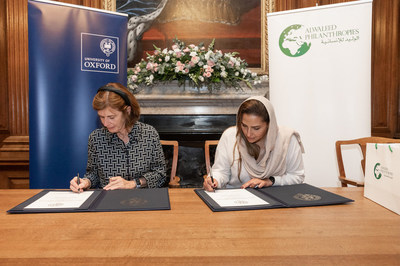
View On WordPress
0 notes
Text
Precious and Rare: Islamic Metalwork from The Courtauld

"Islamic metalwork — more than any other form of Islamic craftsmanship — represents a meeting point of different cultures, patterns, and traditions. Drawing on some of the finest objects from the Middle East, Africa, and Europe, Cultures in Conversation presents a modern-day interpretation of Islamic metalwork in The Courtauld Gallery and the History of Science Museum collections. From stunning court fashion and intricate astrolabes to beautiful bowls and candlesticks, immerse yourself in six centuries of Islamic artisanship. Discover how each precious and rare object is a cultural conversation which starts and ends in a different place. And those cultural conversations continue today in the online exhibition, with objects and stories from the Multaka-Oxford volunteers and local community — including an interactive digital programme where online visitors can design their own Islamic-inspired patterns. ..."
University of Oxford (Video)
0 notes
Text
#24 Modern Purpose of the Astrolabe – Educational Programmes
Pedro explained that he had been studying the shift in perspectives towards the astrolabe. That it had originally been seen as a mathematical instrument, and people would study its perspective on the stars and its design and examine the accuracy of the specific instrument.
However, he now sees a shift and that it is being used more as a ‘cultural connector’. He has seen that museums, planetariums, various collections do still present the astrolabes in ‘an antiquarian perspective’ by exploring the parts of the astrolabe, the materials, how its technology works etc. But now sees people paying more attention to the cultural dimensions, how it encapsulates the circulation of knowledge and scientific instruments through different cultures.
Importantly, he points out that it is now being used to foster dialogue between these different cultures. He noted a few programmes, such as the award-winning Multaka-Oxford project at the History of science museum in Oxford.
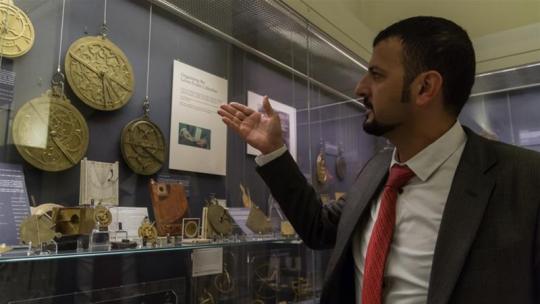
Their website explores their aim, stating:
Multaka means 'meeting point' in Arabic and the project has empowered refugees and asylum seekers in Oxford to join a team of volunteers at the Pitt Rivers Museum and the History of Science Museum to share their knowledge and passion for Islamic art, science and culture.
Through these programmes, it allows for members of the Islamic community and people from the Middle East to provide first-hand knowledge of their own culture. They are illustrating this culture through using scientific instruments, like the astrolabe.
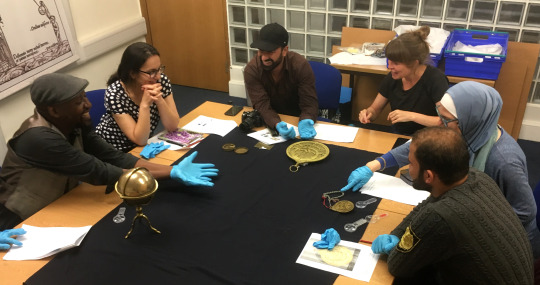
Another programme he noted was the ‘In Transit’ project by the ‘Nasher Museum of Art at Duke University’ and that two of the Adler’s astrolabes were currently being used in this programme. Here, they have been using the astrolabes to tell a story of how knowledge of astronomy and of scientific instruments have intertwined between different cultural spaces.
Another two Adler astrolabes are also currently on loan to the ‘Caravans of Gold, Fragments in Time: Art, Culture, and Exchange across Medieval Saharan Africa’ at the Chicago Block Museum of Art which utilises the objects to showcase the Sahara desert as a place of economic, artistic, and scientific change.
Importance of these projects
Pedro noted be believed the importance of these projects to illustrate the significant influence of Islamic astronomers and astrologists on modern day astronomy.
He believes this is important when you study the ‘scientific revolution’ of the seventeenth century as many well-known names of modern science, like Copernicus, utilised knowledge from Islamic astronomers, optics and medics.
He remarked that without studying the importance of the Islamic culture and its influence then you cannot begin to understand the origins of modern science.
Thus, through these projects it fosters a dialogue on the importance of mutual understanding and cultural connections to help fight prejudices against different cultures. He emphasised the importance of this in our current cultural climate with issues like cultural prejudices of Islamophobia, the refugee crisis, and restrictions on freedom of movement.

He remarked that our current instant transfer of knowledge is just an advanced version of the transfer of knowledge of the Astrolabe days.
He believes these exhibitions stem from the intention of showing ultimately that science is at the heart of the history of economic transactions, this involves the transfer of knowledge across different cultures.
Pedro closed by stating he feels that without this sharing of information and freedom of movement then you would not have the scientific and technological advances our modern world has seen, and you would not have hot-beds of innovation, like that of Silicone Valley. Thus, he sees these projects as ultimately trying to fight against these artificial divides.
Image Credits: History of Science Museum, Oxford
20/04/2020
0 notes
Text
The Use of Mother-of-Pearl Shell in Siwan Embroidery

Mother-of-pearl is valued for its attractive shine and protective properties. In the Western Desert of Egypt, the women of Siwa Oasis use mother-of-pearl buttons called Tutintfukt in their embroidery. The Jenny Balfour-Paul Collection at the Pitt Rivers Museum includes many such beautifully decorated pieces.
The sun is a common motif in Siwan embroidery with Tutintfukt meaning “eye of the sun” being deliberately chosen for their iridescence. This capability to both absorb and reflect the sun’s rays is said to create a barrier of protective light over the wearer. Buttons are often arranged in sunburst patterns or clustered in groups of 3, 5 and 7 which are considered auspicious numbers.
The community have retained their traditional methods of embroidery due to Siwa’s remote location, flanked on all sides by desert. Nevertheless, the mother-of-pearl used has travelled great distances to reach them, from as far as the Arabian Sea and Indian Ocean. Shells are traded by merchants along Trans-Saharan trade routes and later crafted into buttons by artisans.
Buttons are especially stitched into bridal clothes and wedding items such as the basket above. Mothers begin to collect materials for their daughter’s bridal outfit on her third birthday. Every button is checked meticulously during the selection process. Buttons must be bright white and free of blemishes or decolourisation. More recently, plastic buttons and sequins are also used as they are more readily available.
Louise Thandiwe Wilson, Multaka-Oxford Collections Officer
Image: Wedding basket, woven palm leaf decorated with mother-of-pearl buttons, red leather and silk tassels (2018.37.63 ©Pitt Rivers Museum, Jenny Balfour-Paul Collection)
5 notes
·
View notes
Text
University of Arts London- Central Saint Martins Students visit Multaka
The exhibition ‘Connecting Threads’ curated by Multaka volunteers and featuring textiles from the Arab World ran from April 2019 until February 2020. Although the showcase had been deinstalled, students from Central Saint Martins Fashion History & Theory BA (University of the Arts London) managed to catch a last chance to view objects from the display at the Pitt Rivers Museum. Course Leader Cally Blackman and her students were keen to see the exhibition contents, speak to the Multaka volunteers who had curated the display and learn more about the Multaka project, in order to explore the possibility of creating similar approaches or projects in the future.
After an introduction to the Museum, Niran (who is one of the ‘Connecting Threads’ Multaka co-curators) and myself brought everyone into the Museum’s seminar room to view objects and labels from the display. We spoke about the Textiles from the Arab World Collection donated by Jenny Balfour-Paul, and how this collection had inspired the ‘Connecting Threads’ exhibition. Niran spoke about how she and the other Multaka volunteers worked with Museum staff. These are a few themes that came up:
1. Co-production
Experience and skills were shared between the Multaka volunteers and Museum staff involved in the exhibition team. This was an entirely collaborative project: volunteers were included at every step from initial development to design and to its launch. The team unanimously decided on everything including the choice of its star object, the beautiful coral and red silk embroidered dress from Syria.
"The Multaka Project demonstrated how such institutions like Pitt Rivers could be a connecting point for cultures and histories. The choice of objects was truly incredible, however through the multi-vocal, -lens, and -layer approach it made an even greater impact"
Central St Martins Student
2. Contextualisation
Objects were not presented in isolation: they were considered as both independent and part of a collection. Volunteers included Museum and personal objects producing many different narratives, with a common thread. The volunteers’ exhibition labels discussed everything from ethical collection acquisition and cultural practice, to production techniques and trade. This provided context, which enhanced the understanding of the collection and revealed the rich array of lenses through which we can understand objects.
3. Language
The exhibition team decided it was important to create a bilingual exhibition. Labels were written in both English and Arabic for our linguistically and culturally diverse visitors.
____
Students particularly enjoyed speaking to Multaka our volunteer Niran about her experiences co-producing the exhibition. In her own words:
In February, Nicola (the manager of the project), Thandi (the collections officer) and I (as one of the five volunteers who had produced ‘Connecting Threads’) received eleven students from Central Saint Martins University of the Art in London with their professor to share with them our experience and how we produced it!! The students’questions were of a high level of understanding and knowledge, they asked with interest about all of the details such as:
What is the meaning of Multaka and in which language?
How did we get the objects?
The names of embroidered shapes on clothes?
Which cities and ages did the objects come from?
How long did it take to accomplish?
Finally, before they left, they said: we are hoping to do the same!! Here, I proudly realised that the exhibition ‘Connecting Threads’ has become a subject taught and the effort that we made will not stop, but will continue and keep achieving the goal of Multaka, which is the participation of different cultures everywhere and every event.
Louise Thandiwe Wilson, Multaka-Oxford Collections Officer
Image: ©Pitt Rivers Museum, Jenny Balfour-Paul Collection

2 notes
·
View notes
Photo


A sneak peek at a beautiful embroidered thōb from Saraqib, Syria, which volunteers have been looking at for our co-produced Multaka exhibition, which will appear at the Pitt Rivers Museum in April.
2018.37.4 ©Pitt Rivers Museum
4 notes
·
View notes
Photo
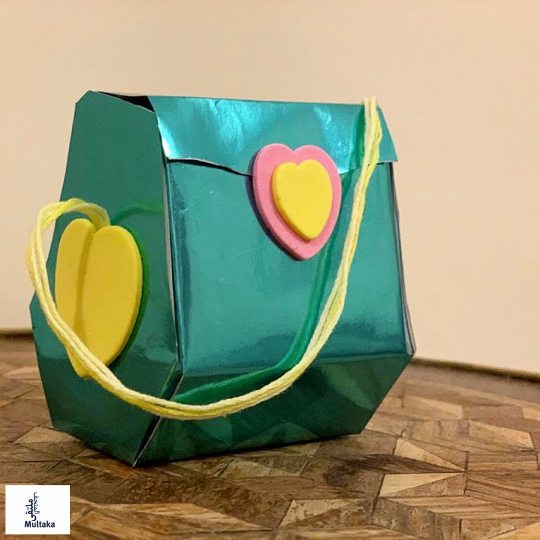
A pretty Handbag made by Jenan one of our Multaka volunteers for the Oxford's Christmas Light Festival 👝✨ #museumsathome #museumsfromhome #multaka #oxford #multakaoxford #oxlightfest20 #bag #handbag #mousel https://www.instagram.com/p/CIDzC5CsKsc/?igshid=evru9v1m9mfe
1 note
·
View note
Photo
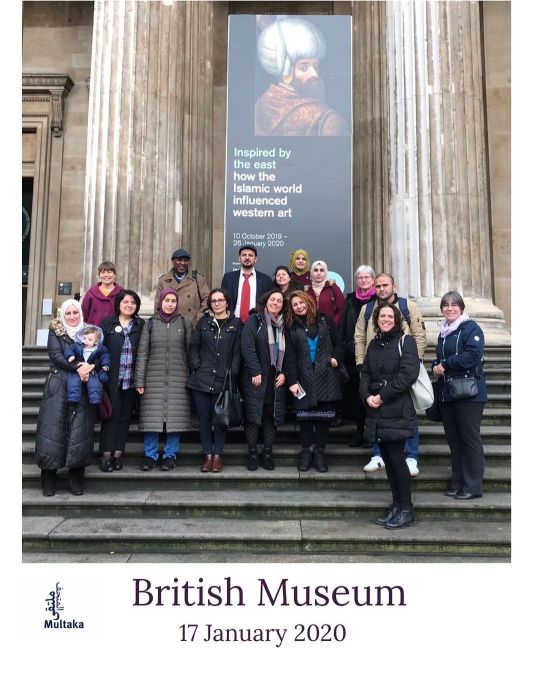
From our visit to @britishmuseum with our volunteers! @hsmoxford @pittriversmuseum #multaka #multakaoxford #britishmuseum #oxford #trip #islamicmetalwork #volunteers https://www.instagram.com/p/CHK6qlgMi6e/?igshid=za9lgsdazgoa
0 notes
Photo

Our event planner Niran!💫 #multaka #multakaoxfordproject #oxforduniversity #oxfors #volunteer #museum https://www.instagram.com/p/CHFlsgBsbll/?igshid=1strx7k3rgcsp
0 notes
Text
Gargush

This is a cap for women is called Gargush, its from #Yemen and is part of the "Textiles from the Arab World" collection Pitt Rivers Museum donated by Jenny Balfour-Paul.
It's decorated with silk and intricate metallic thread embroidery.
0 notes